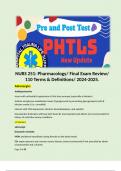NURS 251: Pharmacology/ Final Exam Review/
110 Terms & Definitions/ 2024-2025.
Adrenergics
Antihypertensive
Issues with orthostatic hypotension & first dose syncope (especially α blockers)
Asthma and glucose metabolism issues (hypoglycemia by preventing glycogenolysis) with β
blocker combo's (i.e. carvedilol)
Interact with CNS depressants (alcohol, benzodiazepines, and opioids)
Nonselective β blockers will have both heart β1 and respiratory β2 effects; β1 recommended for
history of restrictive airway conditions
a1 blockers
adrenergic
Doxazosin mesylate
MOA: peripheral vasodilator acting directly on the blood vessel
CO: angina pectoris and coronary artery disease; induces tachycardia if not preceded by admin
of propranolol and a diuretic
Page 1 of 50
,AE: vomiting and diarrhea, urinary frequency, cardiovascular collapse (especially if given with
hydralazine without lowering the dose of the latter); drowsiness, lack of energy, and weakness
a2 agonist
adrenergic
Clonidine
centrally acting; norepinephrine and blood pressure
MOA: acts through CNS through centrally mediated alpha-adrenergic stimulation in the brain,
producing blood pressure reduction
CO: severe coronary artery disease, pregnancy
AE dry mouth, drowsiness, headaches, fatigue, anorexia, malaise, vomiting, mild liver function
disturbance, sleepiness, constipation, impotence
NI: rebound or withdrawal hypertension common; monitor BP when discontinuing medication
Diuretics
Anithypertensive
hydrocholrothiazide
first line therapy
MOA: decreases • plasma and ECF volumes. Results
- Decreased preload, cardiac output, and total peripheral resistance
Overall effect: Decreased workload of the heart and decreased BP.
directly affects vascular smooth muscle
CI: gout, know sensitivity to sulfa drugs, severely impaired kidney function, hx of hyponatremia
AE: dry mouth, thirst, weakness, drowsiness, lethargy, muscle aches, muscular fatigue,
tachycardia, GI disturbances
NI: monitor for signs of electrolyte imbalance, encourage intake of potassium-rich foods (i.e.
fruits), gerontologic: risk of postural hypotension significant due to volume depletion; measure
BP in three positions; caution patient to rise slowly
monoclonal antibodies
Page 2 of 50
,Suffix ending 'mab'
Indications: treatment of cancer, RA, MS, and organ transplantation
Specifically target cancer cells and have minimal effect on healthy cells
Fewer AE's than traditional antineoplastic medications
CI: active TB and other infections
Different Types
Infliximab (Remicade) For RA, Crohn's
Natalizumab (Tysabri) For MS
· Adalimumab (Humira)
For RA
· Rituximab* (Rituxan)
For NHL
Associated with allergic response especially Ritux; premedicate with diphenhydramine and
acetaminophen
Dual action α1 and β receptor blockers
adrenergic
nebivolol promoted as causing less sexual dysfunction than Clonidine
beta blockers
adrenergic
Metoprolol
• Reduce angiotensin mediated vasoconstriction
• Reduce aldosterone mediated fluid expansion
• Reduce peripheral vascular resistance
• Reduce heart rate through β1 blockade
MOA:
• Reduction of the heart rate through β1-receptor blockade
• Cause reduced secretion of renin
• Long-term use causes reduced peripheral vascular resistance.
Page 3 of 50
, • Block sympathetic nervous system (beta-adrenergic receptors) especially those to the heart,
producing a slower HR and lowered BP
CI: bronchial asthma, allergic rhinitis, right ventricular failure from pulmonary hypertension,
heart failure, depression, diabetes, dyslipidemia, heart block, peripheral vascular disease, HR
<60 bpm
AE: depression (insomnia, lassitude, weakness, and fatigue); light headedness and occasional
nausea, vomiting, epigastric distress
NI: avoid sudden discontinuation; check HR before administering; Geriatrics: risk of toxicity with
¯ renal and liver function. Take BP in three positions, and observe for hypotension
Dual-Action α1- and β-Receptor Blockers
Adrenergic
labetalol
• Dual antihypertensive effects of reduction in heart rate (β1-receptor blockade) and
vasodilation (α1-receptor blockade)
MOA: block alpha- and beta- adrenergic receptors; cause peripheral dilation and ¯ peripheral
vascular resistance
CO: asthma, cardiogenic shock, severe tachycardia, heart block
AE:orthostatic hypotension, tachycardia
ACE inhibitors
suffix ending -pril
MOA:
• Inhibit ACE, which is responsible for converting angiotensin I (through the action of renin) to
angiotensin II
• Angiotensin II is a potent vasoconstrictor and causes aldosterone secretion from the adrenal
glands.
• May be in combination with CCB and thiazide diuretic (Coversyl Plus LD is perindopril and
indapamide)
• Captopril has a short half-life (bid - tid); a drawback is nonadherence
• Captopril and lisinopril are the only two ACE inhibitors that are not prodrugs (good for pt. with
liver dysfunction)
• Newer ACE inhibitors have longer half-life (once daily benefit)
Page 4 of 50




